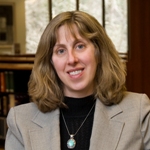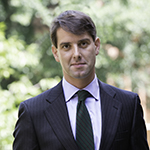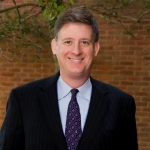Clerking for the highest court
All law students examine its precedent cases. Some have a favorite justice. At the very least, they recognize the meaning of the abbreviation SCOTUS.
As the highest federal court in the land, the Supreme Court of the United States is, for some, shrouded in a cloud of mystery. Those in pursuit of law degrees familiarize themselves with its decisions, but only a select few ever receive the opportunity to clerk for one of its justices and witness the inner workings of the court.
Five former clerks are members of the William & Mary Law School faculty: Nancy Combs, Allison Orr Larsen, Alan Meese, William & Mary President Taylor Reveley (who clerked for Justice William J. Brennan, Jr., during the court’s 1969 term) and James Stern. Their experiences allowed them to learn more about the law, its processes and exactly what it means to be chosen as a Supreme Court clerk.
It all starts at the end of law school. Most law school graduates who eventually clerk for the Supreme Court begin by clerking for a circuit court judge. They gain invaluable experience writing memos and learning about the way courts run before competing against nearly a thousand other applicants for one of the 36 coveted clerkship positions.
The application process is similar to that of any job. Applicants generally submit a resume and letters of recommendation to all nine justices before being interviewed. The structures of the interviews vary depending on the justice.

But the application process consists of more than just interviews. Applicants need excellent grades, solid recommendations, experience and luck. Only those who possess the right combination will qualify for a clerkship.

"A lot of getting that clerkship, frankly, is just luck," said Professor Allison Orr Larsen, who clerked for Justice Souter during the 2005 term. "There are many qualified people who don't get that lucky call, so I consider myself very fortunate to have had that interview."
Once the clerks are appointed, the real work begins. Although the Supreme Court grants certiorari to about 80 cases per year, the court receives more than 10,000 petitions. The clerks bear the responsibility of sifting through them and writing memoranda to present to the justices. Throughout this process, the clerks perform several essential tasks.
First, they read the petitions for certiorari. Because the Supreme Court has a discretionary docket, it only hears cases it chooses to hear. Professor James Stern, who clerked for Justice Kennedy during the 2010 term, said the clerks act as the "front line" in the selection process by providing a summary of each case and a recommendation as to whether the justice should vote to hear the case.
All of the current justices except Justice Alito participate in the "cert pool," a system that distributes memo assignments among the clerks in each chamber. A copy of each petition goes into the pool and is randomly assigned to a clerk from the pool. That clerk then writes and circulates a memo for all the justices participating in the pool. After the justices receive and review the memos, they hold a meeting to decide which cases to grant.
After an initial vote, the senior member of the majority assigns the opinion to another justice in the majority for each of the chosen cases. One of that justice's clerks then becomes responsible for helping the justice draft the opinion.
No part of the reading, writing or opinion drafting ever ends throughout the term. Instead of disappearing from the clerks' list of responsibilities, old tasks must be completed in addition to new assignments. The work never truly ends.
Despite the intensity of their workloads, the former clerks enjoyed their experiences as a whole--particularly the incredible opportunities to interact with the justices on both a professional and personal level.
"Sometimes you think of these people as public figures, and they are, but they're also people--they're humans--and they have a personal side," Larsen remarked. "I really liked getting to know that side of them."
Justice O'Connor occasionally held a morning yoga class for female clerks. Larsen attended one morning and was enlisted as Justice O'Connor's stretching partner.
"Gosh, I hope I don't break Justice O'Connor!" Larsen remembers thinking. "She's a national treasure, and I'm pulling her arms behind her back."
Stern played in "The Highest Court in the Land," the aptly-named basketball court on the fifth floor of the Supreme Court building. He also went to a Giants game with Justices Kennedy and Sotomayor and followed tradition by taking other justices to lunch with the clerks in his chamber.
In addition to anecdote-worthy memories, clerks gain invaluable knowledge and experience from reading and briefing cases and listening to oral argument on a variety of topics. "You get a wide selection of things from Indian tribal law to ERISA, to antitrust, lots of criminal cases, lots of immigration cases, constitutional law, " said Stern. "You name it, it all comes in."
 Professor Alan Meese, who clerked for Justice Scalia during the 1990 term, believes the exposure to so much subject matter, especially constitutional law, allows clerks to become more well-rounded than they would be just working in one area of law. "Clerking helps you become a generalist," he said after reflecting on the way clerking broadened his knowledge of the law.
Professor Alan Meese, who clerked for Justice Scalia during the 1990 term, believes the exposure to so much subject matter, especially constitutional law, allows clerks to become more well-rounded than they would be just working in one area of law. "Clerking helps you become a generalist," he said after reflecting on the way clerking broadened his knowledge of the law.
The import of the court's work is powerfully illustrated in death penalty cases. Whenever a death penalty case arose, the justice selected one clerk from each chamber to work on that assignment. Clerks remained at the office if an execution was to take place, regardless of the time of day, due to the possibility of last-minute appeals.
Combs recalled leaving the office at 3 a.m., after it was decided that the appeal in a California death penalty case would be denied. As she walked to her car and sat down in the driver's seat she finally processed the enormity of the decision.
"Before I could drive, I found myself filled with emotion," she recalled. "The government had just put a man to death, and I had been part of that--a small part, but nonetheless a part."
All four of the professors share a profound appreciation for the opportunity they had to clerk for the court.
"If you have one take-home point from me, it's just how fortunate I feel to have clerked on the court, because it's rare, and it's life-changing," Larsen said, a sentiment echoed by her colleagues. "I feel exceedingly grateful to have had that experience."
 Skip to main content
Skip to main content
